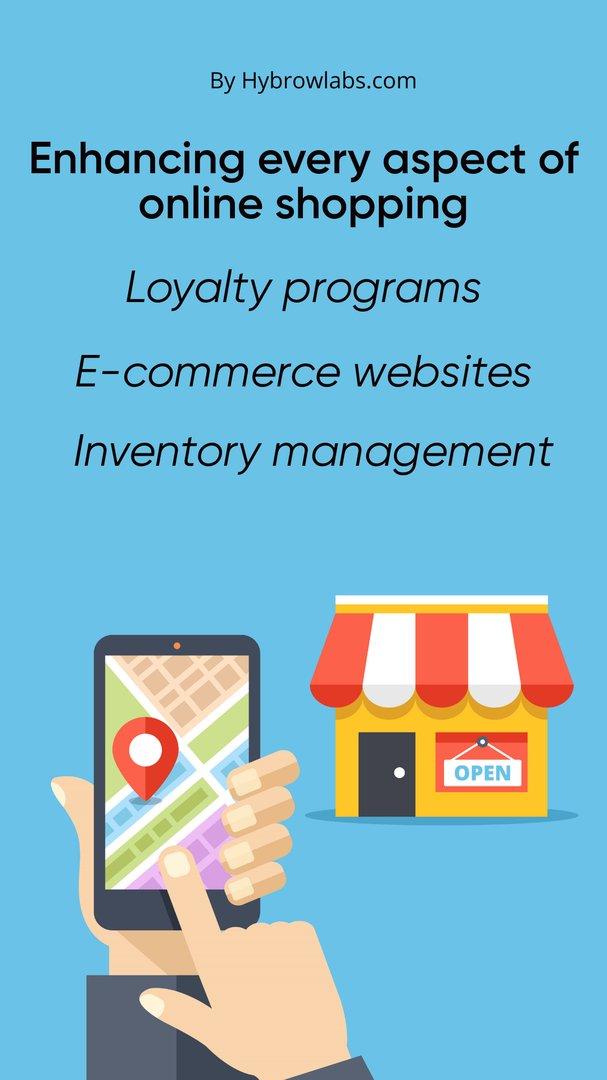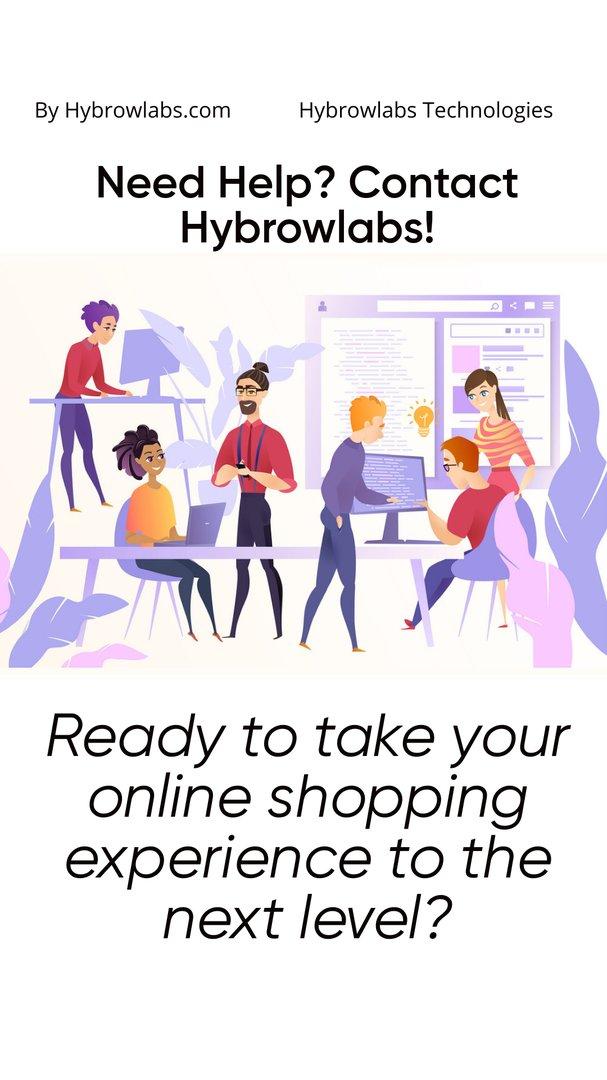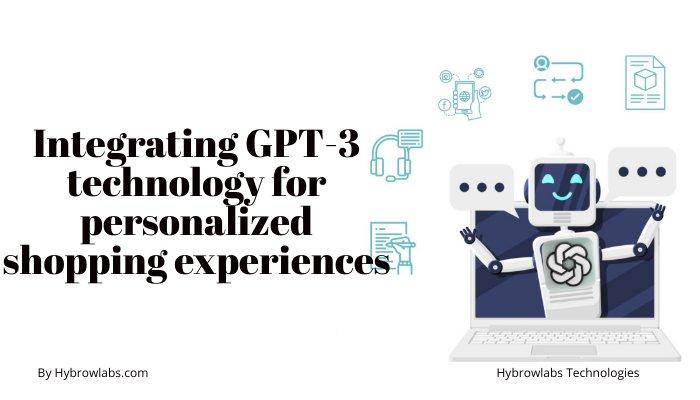Introduction:

Personalization has become a buzzword in the world of e-commerce, with businesses increasingly seeking ways to create tailored shopping experiences for their customers. Personalization involves utilizing customer data to deliver relevant & targeted experiences that align with their preferences, behaviors, & interests.
GPT-3 (Generative Pre-trained Transformer 3) technology has emerged as a powerful tool for businesses seeking to deliver personalized shopping experiences. GPT-3 is an artificial intelligence language model developed by OpenAI that can generate human-like responses to text input. It has a vast database of information & can learn from previous interactions, making it an ideal tool for creating personalized shopping experiences.
The integration of GPT-3 technology in the e-commerce industry has been revolutionary, as it allows businesses to provide personalized experiences at scale. This technology can understand natural language, making it easier for businesses to engage with customers & provide them with the relevant information they need.
Importance of creating personalized experiences through GPT-3 Technology:

There are several reasons why GPT-3 technology is important for creating personalized shopping experiences.
- Firstly, It allows businesses to provide a more personalized experience for their customers. By understanding customer preferences & behaviors, businesses can tailor their products, services, & marketing messages to meet their needs.
- Secondly, Personalized shopping experiences can lead to increased customer loyalty & retention. Customers who feel valued & understood are more likely to return to a business & recommend it to others.
- Thirdly, GPT-3 technology allows businesses to automate personalized experiences, reducing the need for human intervention. This can lead to cost savings & increased efficiency, as businesses can provide personalized experiences at scale.
- In conclusion, The integration of GPT-3 technology in the e-commerce industry has been transformative, enabling businesses to deliver personalized shopping experiences that meet customer needs & preferences. By understanding customer data & leveraging the power of GPT-3, businesses can create meaningful connections with their customers & drive long-term success.
Understanding GPT-3:
GPT-3 (Generative Pre-trained Transformer 3) is an advanced natural language processing (NLP) technology developed by OpenAI. It is the third & most powerful iteration of the GPT series, with 175 billion parameters, making it one of the largest NLP models available.
The technology uses unsupervised learning techniques to generate human-like text by predicting the most probable next word in a given context. It can understand & generate text in a wide range of languages, styles, & formats, from simple sentences to complex paragraphs, essays, & even programming code.
Integrating GPT-3 in Specific Fields of Personalized Shopping Experiences:

GPT-3 technology, with its ability to generate human-like responses & understand natural language, has the potential to revolutionize the retail industry by providing personalized shopping experiences to customers. In this article, we will explore specific fields or departments within the retail industry where GPT-3 technology can be integrated for personalized shopping experiences.
1. E-commerce websites:
One of the most popular applications of GPT-3 technology in the retail industry is e-commerce websites. By using natural language processing, GPT-3 can understand customer queries & provide relevant product recommendations based on their search history, browsing behavior, & purchase history. Additionally, GPT-3 can generate personalized product descriptions, making it easier for customers to find what they are looking for.
2. Customer service & support:
GPT-3 can also be integrated into customer service & support to provide personalized assistance to customers. By analyzing customer data, GPT-3 can generate responses to customer queries that are tailored to their specific needs & preferences. This not only enhances the customer experience but also reduces the workload of customer support representatives.
3. Product descriptions & reviews:
GPT-3 technology can also be used to generate product descriptions & reviews that are personalized to the customer. By analyzing customer data, GPT-3 can generate descriptions & reviews that are tailored to the customer's interests, preferences, & purchase history. This can help customers make informed purchase decisions & increase their overall satisfaction with the product.
4. Marketing & advertising:
GPT-3 technology can be used to generate personalized marketing & advertising campaigns that are tailored to the customer's interests & preferences. By analyzing customer data, GPT-3 can generate targeted advertisements that are more likely to appeal to the customer. This can lead to increased customer engagement & sales.
5. Virtual shopping assistants:
GPT-3 technology can also be used to create virtual shopping assistants that can help customers find the products they are looking for. By analyzing customer data, GPT-3 can generate responses to customer queries that are personalized to their needs & preferences. This can help customers find what they are looking for faster & more efficiently.
6. Inventory management:
GPT-3 technology can also be used to improve inventory management by predicting customer demand & generating personalized recommendations for inventory management. By analyzing customer data, GPT-3 can predict which products are likely to be in high demand & generate recommendations for inventory management that are tailored to the customer's preferences & purchase history.
7. Loyalty programs:
GPT-3 technology can also be used to improve loyalty programs by generating personalized rewards & incentives for customers. By analyzing customer data, GPT-3 can generate rewards & incentives that are tailored to the customer's interests & preferences. This can help increase customer engagement & loyalty to the brand.
In conclusion, GPT-3 technology has the potential to revolutionize the retail industry by providing personalized shopping experiences to customers.
How GPT-3 can be integrated into online shopping platforms:
1. Determine use cases:
Before integrating GPT-3 into an online shopping platform, it is important to determine the use cases. GPT-3 can be used for various applications such as chatbots, search functionality, pricing optimization, & image analysis. It is important to identify the specific use cases that would benefit the business & its customers.
2. Access GPT-3 API:
To integrate GPT-3 into an online shopping platform, access to the GPT-3 API is required. GPT-3 API provides access to the language processing capabilities of GPT-3, enabling developers to create applications that can understand & generate human-like text.
3. Data collection & preprocessing:
To train GPT-3 models for personalized shopping experiences, data collection & preprocessing are essential. This involves collecting customer data such as browsing history, purchase history, & customer feedback. The data is then preprocessed to remove irrelevant information & to make it suitable for training GPT-3 models.
4. Train GPT-3 models:
GPT-3 models are trained using preprocessed data to provide personalized shopping experiences for customers. The models are trained to understand customer preferences & to generate recommendations that are tailored to each customer.
5. Develop APIs:
After the GPT-3 models are trained, APIs need to be developed to enable integration with the online shopping platform. The APIs allow the GPT-3 models to interact with the online shopping platform & provide personalized recommendations to customers.
6. Implement chatbots:
Chatbots can be implemented using GPT-3 to provide customers with personalized assistance. Chatbots can answer customer queries, provide recommendations, & assist with the checkout process.
7. Improve search functionality:
GPT-3 can be used to improve search functionality by providing personalized search results for customers. The search functionality can be enhanced by understanding customer preferences & providing search results that are tailored to each customer.
8. Optimize pricing:
GPT-3 can be used to optimize pricing by understanding customer preferences & providing personalized pricing recommendations. This can help businesses to increase customer satisfaction & improve sales.
9. Implement image analysis:
GPT-3 can be used for image analysis to provide personalized product recommendations based on visual similarities. This can help customers to find products that are visually similar to products they have liked or purchased in the past.
10. Testing & optimization:
After the GPT-3 technology is integrated into the online shopping platform, testing & optimization are essential to ensure that the personalized shopping experience is working as intended. Testing involves checking the accuracy of recommendations & the overall user experience. Optimization involves fine-tuning the GPT-3 models to provide better recommendations over time.
Benefits of Integrating GPT-3 Technology for Personalized Shopping Experiences:
1. Ability to Generate Human-Like Text:
GPT-3 has the ability to generate human-like text that can mimic the style & tone of a human. With its advanced language capabilities, GPT-3 can generate product descriptions, reviews, & recommendations that feel like they were written by a real person. This human-like text can enhance the overall shopping experience & make it more engaging for the customer.
2. Automatic Text Completion & Summarization:
GPT-3 can automatically complete & summarize text, which can be helpful in providing personalized recommendations to customers. By analyzing a customer's purchase history & browsing behavior, GPT-3 can suggest products that the customer is likely to be interested in. This can save time for both the customer & the retailer by providing relevant information in a concise manner.
3. Contextual Understanding of Text:
GPT-3 has contextual understanding capabilities, which means it can analyze text & understand its meaning based on the context. This can be helpful in providing personalized recommendations to customers by understanding their preferences & interests. For example, GPT-3 can understand that a customer who frequently purchases fitness-related products may also be interested in healthy food products.
4. Large Scale Data Processing & Analysis:
GPT-3 can process & analyze large amounts of data, which can be helpful in providing personalized recommendations to customers. By analyzing data from multiple sources, such as purchase history, browsing behavior, & social media activity, GPT-3 can provide a comprehensive view of a customer's preferences & interests.
5. High Accuracy in Language Translation:
GPT-3 has high accuracy in language translation, which can be helpful in providing personalized shopping experiences to customers in different languages. With its multilingual capabilities, GPT-3 can translate product descriptions, reviews, & recommendations into different languages, making it easier for customers to shop in their preferred language.
6. Multilingual Capabilities:
GPT-3 has multilingual capabilities, which means it can process & analyze text in multiple languages. This can be helpful in providing personalized shopping experiences to customers who speak different languages. By analyzing data in multiple languages, GPT-3 can provide a comprehensive view of a customer's preferences & interests, regardless of their language.
7. Speed & Efficiency in Text Processing:
GPT-3 is fast & efficient in processing text, which can be helpful in providing real-time personalized shopping experiences to customers. By analyzing data in real time, GPT-3 can provide personalized recommendations to customers based on their current browsing behavior, increasing the likelihood of a sale.
8. Integration with Other Technologies:
GPT-3 can be integrated with other technologies, such as chatbots & virtual assistants, to provide a seamless shopping experience to customers. By integrating GPT-3 with chatbots, for example, retailers can provide personalized recommendations to customers in real time, increasing the likelihood of a sale.
9. Accessibility & Ease of Use:
GPT-3 is accessible & easy to use, which means it can be used by retailers of all sizes to provide personalized shopping experiences to their customers. With its easy-to-use API, GPT-3 can be integrated into existing e-commerce platforms, making it easier for retailers to implement personalized shopping experiences.
Examples of companies that have successfully integrated GPT-3 for personalized shopping:
Here are a few examples of companies that have successfully integrated GPT-3 technology for personalized shopping experiences:
1. Nike:
Nike, the global leader in sportswear, has integrated GPT-3 technology into its mobile app to create a more personalized experience for its customers. The app uses natural language processing to understand customer requests & preferences, allowing them to find the perfect pair of shoes or apparel easily. With GPT-3, Nike's mobile app can provide personalized recommendations based on a customer's activity, location, & previous purchases, making the shopping experience more enjoyable & streamlined.
2. Sephora:
Sephora, the beauty retailer, is using GPT-3 technology to offer customers personalized skincare recommendations. Sephora's "Sephora Virtual Artist" feature allows customers to upload a photo & receive customized skincare recommendations based on their skin type, tone, & concerns. The technology analyzes the photo & provides personalized product recommendations, making the shopping experience more convenient & tailored.
3. H&M:
H&M, the fast-fashion retailer, has integrated GPT-3 technology into its website to offer personalized outfit recommendations to customers. The website's "Outfit Recommender" feature allows customers to input their preferences, & the technology uses natural language processing to suggest outfits that match their style & preferences. This feature has helped H&M increase customer engagement & sales, as customers are more likely to purchase items that match their style & preferences.
Conclusion:

In conclusion, integrating GPT-3 in online shopping can provide numerous benefits for personalized shopping experiences. Firstly, it can offer personalized product recommendations, which can increase the chances of a customer making a purchase. Secondly, GPT-3 can assist in creating personalized shopping experiences by understanding customers' needs and preferences, thereby enhancing customer satisfaction.
Looking toward the future, the integration of GPT-3 in online shopping is likely to become more widespread. As technology continues to advance and improve, it will become more affordable and accessible for businesses of all sizes. Additionally, the potential for GPT-3 to provide more accurate and personalized shopping experiences will continue to make it an attractive option for retailers looking to improve customer satisfaction and increase sales. For professional assistance in implementing GPT-3 technology in online shopping, consider using the Hybrowlabs Development Service.
FAQ:
1. What is GPT-3, & how can it be used for personalized shopping experiences?
GPT-3 is a state-of-the-art language model that can generate human-like text. It can be used to create personalized shopping experiences by analyzing customer data & generating personalized product recommendations, descriptions, & even chatbots that can assist customers in making purchases.
2. How do I integrate GPT-3 into my e-commerce platform?
There are several ways to integrate GPT-3 into your e-commerce platform, depending on your specific needs. Some options include using pre-built APIs or integrating GPT-3 through a custom-built application. You may also need to work with a developer or AI specialist to ensure that the integration is successful.
3. What are some benefits of using GPT-3 for personalized shopping experiences?
Using GPT-3 for personalized shopping experiences can provide several benefits, such as increased customer engagement, higher conversion rates, & improved customer satisfaction. By providing customers with personalized recommendations & chatbots that can assist them in making purchases, you can create a more seamless & enjoyable shopping experience.
4. Are there any limitations to using GPT-3 for personalized shopping experiences?
While GPT-3 is a powerful tool, it is not perfect, & there are some limitations to its use for personalized shopping experiences. For example, GPT-3 may not always be able to accurately interpret customer data or provide accurate recommendations. It is also important to consider the ethical implications of using AI for personalization, such as the potential for bias or discrimination.
5. How can I ensure that my use of GPT-3 for personalized shopping experiences is ethical & compliant?
To ensure that your use of GPT-3 for personalized shopping experiences is ethical & compliant, it is essential to follow best practices & guidelines for AI development & use. This may include conducting regular audits & assessments of your AI system, implementing transparency & accountability measures, & ensuring that your use of AI is aligned with legal & ethical standards. Additionally, it is important to involve stakeholders & users in the development & deployment of your AI system to ensure that their rights & interests are protected.






a3dc85.jpg)
.jpg)
fd8f11.png)


.jpg)
.jpg)